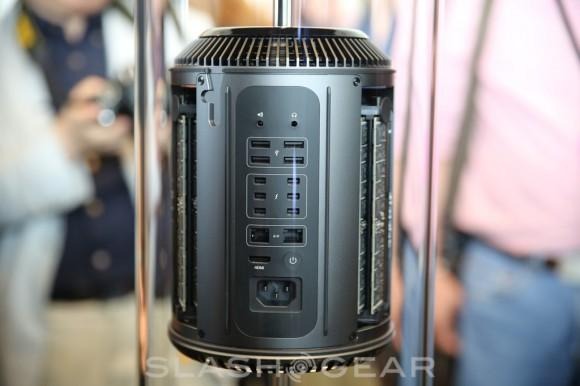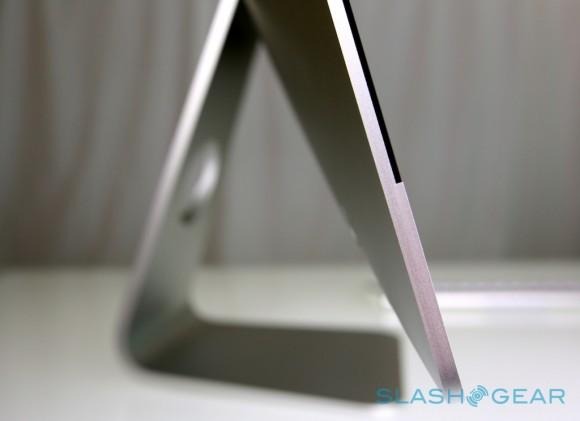Dear Apple, Here's What I Want From The New Thunderbolt Display
The Apple Thunderbolt Display is long overdue a makeover. Revealed in July 2011, the 27-inch monitor has watched generations of MacBook come and go – and, until this year at least, the Mac Pro stagnate with no compatibility whatsoever – and, despite the iMac aesthetic it originally echoed being significantly upgraded last October, still languishes with its original design. Sometimes, with Apple, you have to be patient. The company has, for the most part, a yearly refresh cycle, but the Thunderbolt Display is (in tech terms) old. Still, that arguably just gives Apple the chance to do something particularly special with the new Thunderbolt Display – so here's my wish list.
The current Thunderbolt Display makes most sense when paired with either a MacBook Air or Pro, or the Mac Mini. Its 27-inch, 2560 x 1440 resolution LED-backlit IPS panel still looks great, even several years after its original debut, though it's undeniably lacking in pixels compared to the Retina technology Apple is rolling out on its MacBook Pro notebooks.
What it hasn't played nicely with is the existing Mac Pro, which until the upcoming 2013 iteration has lacked Thunderbolt support. Instead, Apple has kept the older, 27-inch LED Cinema Display around, effectively identical bar the use of a Mini DisplayPort connection.
The new Mac Pro, the stubby cylinder announced to great fanfare at WWDC 2013 last month, in fact introduces Thunderbolt 2 to Apple's range (and the tech world at large). Delivering twice the bandwidth of Thunderbolt, by combining the two 10 Gbit/s channels into one, 20 Gbit/s pipe, it's capable of full 4K UltraHD resolution and, in fact, of simultaneously displaying it on an external screen while also transferring it.
So, Thunderbolt 2 would be the first thing on my shopping list for the new Thunderbolt Display, not least because that extra bandwidth would be useful for turning the monitor into a hub. Since Thunderbolt (1 and 2) supports daisy-chaining up to six devices from a single host port, the use of the newer connection type means even more potential for high-bandwidth applications routed through the display.

The current Thunderbolt Display offers a gigabit ethernet port, FireWire 800, a second Thunderbolt connection for daisy-chaining, and three USB 2.0 ports. A humble upgrade would see that USB switched for the faster USB 3.0 standard.
[aquote]A wish list needn't be humble: I want an external GPU[/aquote]
Still, a wish list needn't be humble, and so what I'd really like to see is the Thunderbolt Display gain its own external GPU. We've already seen some attempts at Thunderbolt-connected external graphics – Lucid showed off one, based on AMD's Radon 6700, back in September 2012; it was capable of boosting a standard ultrabook from native 28fps to 89fps – but the argument for including it in the new monitor makes even more sense when you look at how the rest of Apple's range is developing.
On the one hand, you have the MacBook Air, most recently upgraded with Intel's fourth-gen "Haswell" Core processors. Now, Haswell is great for battery life – we comfortably exceeded Apple's own 12hr runtime predictions, and that's likely to get even longer when OS X Mavericks arrives later this year – but it doesn't do much for graphical crunching. How much better to be able to plug in a new Thunderbolt Display and instantly get the benefit of extra GPU power when you most likely need it, right on the desktop.
The MacBook Pro is more GPU-potent from the start, thanks to its discrete chipset, but it too could still benefit from the addition of standalone graphics support where no compromise for power consumption would be required. The GPU in a new Thunderbolt Display could count on a mains power source, and as such not have to sacrifice any potency in the name of prolonging runtimes.
It's with the new Mac Pro 2013 that such a display enhancement makes most sense, though. The compact diminutive workstation comes with dual-GPUs out of the box, but from the moment Apple first previewed it there were questions as to how upgrade-friendly the double Radeons would be. In fact, the whole Mac Pro redesign shifts from internal improvements to the benefits plugging in external components can bring, whether that be more storage, optical drives, or something else.
So, rather than swap out the onboard graphics, plugging in a new Thunderbolt Display could simply add to them. Mac developer Guy English wrote at length last month about the potential for parallel GPU processing (something AMD itself has been talking about consistently for its last few product cycles too, as part of its Heterogeneous Computing drive) and how the new Mac Pro will open up a fresh age of enormous compute power, along with Apple's apparent shift away from pure benchmark boasts and toward the sort of real-world applications of today.
Even with the slimmed-down design of the current iMac, there's certainly room in the 27-inch model for an extra GPU or two. In fact, since it's my wish list and I can add what I like, I'd probably take up a little more of it with some onboard flash storage, adding to the internal capacity of whatever Mac is plugged in. We've already seen that Thunderbolt (1) external drives with solid-state memory can be as fast as internal drives; certainly enough to manipulate high-resolution video from, without any performance hit compared to when dealing with locally-stored files.

The biggest question is resolution. Right now, the 27-inch iMac runs at 2,560 x 1,440; Apple changed the panel sandwich itself in late-2012, optically-laminating the various layers together so as to improve visual quality, but the sheer number of pixels hasn't been changed for some time. Despite ongoing rumors of a Retina iMac, for one reason or another – likely price and component availability – we're yet to see it happen.
In an ideal world, Apple could step up to Ultra HD resolution (3,840 x 2,160) and blow our eyes away. Thunderbolt 2 certainly supports it. However, there's a dearth of 27-inch Ultra HD panels out there right now; the closest you get, really, is Sharp's 31.5-inch IGZO Ultra HD screen, which we've seen begin to show up in commercial monitors.
Apple is already believed to have an "in" with Sharp, which could certainly give it some leverage for snapping up the coveted panels. That would make for a big Thunderbolt Display 2nd-gen, however, both in terms of price and desk size. One possibility, then, could be a return to the days of multiple Apple display size options: perhaps a 27-inch version, running at the existing resolution, and then a larger model delivering Ultra HD for those that have the depth of wallet for it.
Whether Apple opts to cater to the cash-strapped, Ultra HD seems a case of "when" not "if"; after all, Phil Schiller already billed Final Cut Pro X with 4K support as being one of the key developments for the 2013 Mac Pro, even illustrating it during the WWDC keynote with a shot of a triple display setup powered by the workstation. If Apple doesn't give its highly-paid top tier developers (and traditional Mac Pro audience) the monitors to match, someone else will, and I can't see the canny Cupertino firm allowing itself to miss the opportunity.
The new Mac Pro tells, among many things, the story of Apple's fresh attitude to modularity. Fitting everything bar the kitchen sink into a single box – and leaving room for twice as much again – is the old way; better, Apple seems to be saying, to take advantage of high-speed interconnects like Thunderbolt 2 to grow more organically, adding external components piecemeal as needed.
Apple could simply refresh the Thunderbolt Display with a new casing and the second-gen connection. It'd probably sell plenty, too. Still, I can't help but wish that some of the company's ambition filters down from the team responsible for the new Mac Pro, and the new Thunderbolt Display 2 becomes more than just a screen.
